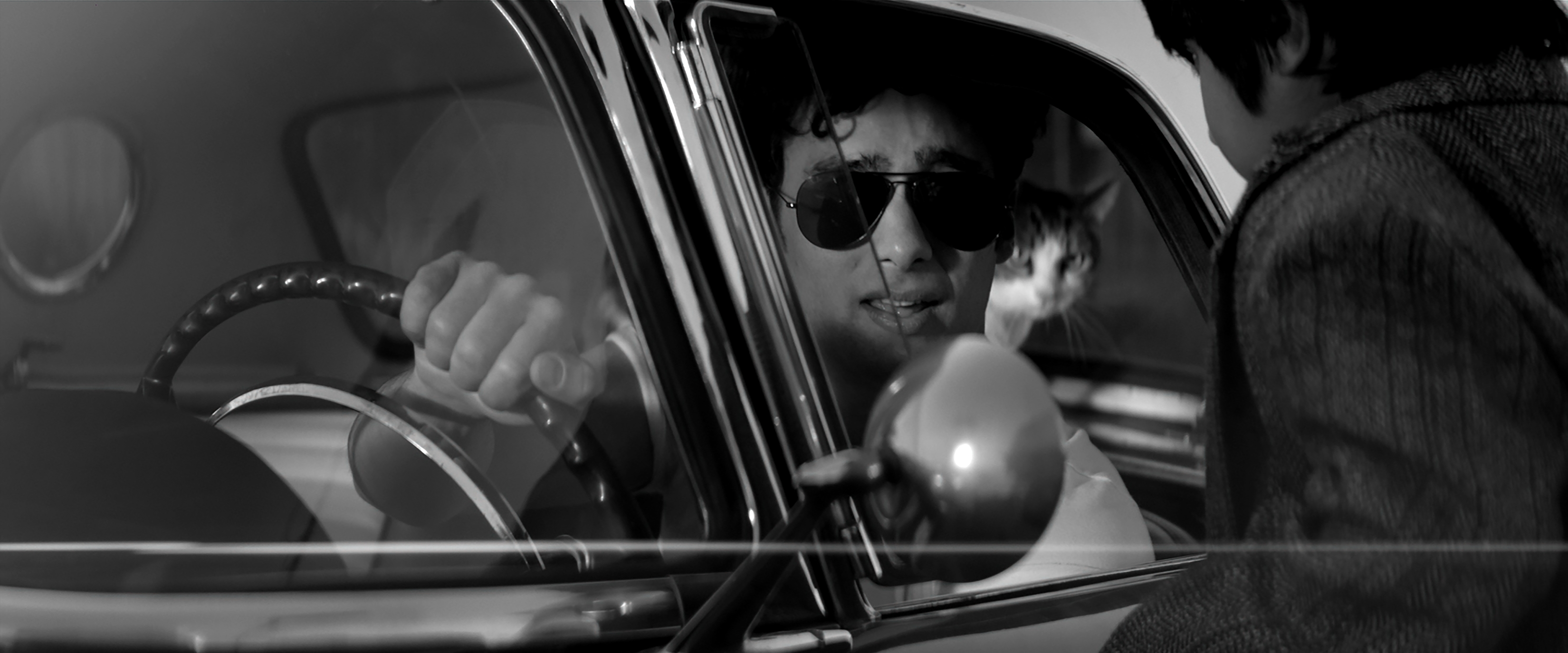 Back to selection
Back to selection
No One Knows About Persian Cats
 Arash Marandi, Masuka, Milad Eghbali
Arash Marandi, Masuka, Milad Eghbali The oft-heard label “Iranian vampire western,” which highlights the pop, postmodern, and cross-generic character of Ana Lily Amirpour’s fresh and potent A Girl Walks Home Alone at Night, inflates its self-proclaimed hype and to-date majority critical evaluation. By these measures, its salient quality is hipness.
A minority of writers have taken a more sociological tack. From a PC vantage point, the director is the first-generation daughter of Iranian immigrants. In addition, vampire films scream tooth-and-nail for ideological deconstruction. You need only scrape the veneer of a film that is largely surface to uncover its denunciations of generalized misogyny, social stratification, and physical abuse, and more specifically, the fundamental structure of contemporary Iranian society.
The jabs run deepest and most oblique in the wondrous selection of music. (Amirpour was lead vocalist for a California girl band.) Several of the groups or singers are Iranian, some still living in Iran, some expats. Their music is mostly a fusion of rock and eastern music, and, in the case of Kiosk, gypsy instrumentals added. Like the film’s dialogue, the lyrics are in Farsi, which most of us don’t understand. Suffice it to say that the title of one of London-based Radio Tehran’s songs is “Gelaye,” which translates into “Complaint.”
 At the same time Amirpour sustains the pastiche effect by incorporating other genres of music, among them the Ennio Morricone-inflected, spaghetti-western numbers performed by Portland’s Federale and L.A.-based Bei Ru’s blend of heavy drums, obscure Middle Eastern records, live instrumentals, and heavy electronics.
At the same time Amirpour sustains the pastiche effect by incorporating other genres of music, among them the Ennio Morricone-inflected, spaghetti-western numbers performed by Portland’s Federale and L.A.-based Bei Ru’s blend of heavy drums, obscure Middle Eastern records, live instrumentals, and heavy electronics.
Whatever the manner of interpretation, I am not claiming that A Woman Walks Home Alone at Night is not an “Iranian vampire western.” It’s most certainly a movie about a Farsi-speaking female vampire exacting revenge for the harmless on the mean streets of a tiny rogue industrial town out West, while simultaneously sating her own dietary and affective needs. It was shot in dusty Taft, California, which, save for some modern machinery and specifically 20th-century architecture, could be a relic of the Old West. Amirpour and the cast are all Iranian. Sheila Vand’s protagonist, known simply as “the Girl,” sleeps during the day and has a vampire’s requisite fangs and pallor. Amirpour succeeds, to a large extent, in collapsing three dissonant subjects.
We get the feel of a compressed mishmash in the character of Arash (German-Iranian actor Arash Marandi), a handsome, muscular young man with thick, curly hair whose courtship of the Girl is reciprocated. His animal magnetism is not of the tough, up-front Wild West variety; rather it stems in large part from his quietude, a sexy restraint evocative of James Dean—a major pop icon, of course—especially the cowboy played by Dean in the neo-western Giant six decades back.

But…the groovy anomalies mislead, in the same way that light rays hit rods and cones in the eyes of a color-blind person at a slightly different angle than in someone with full color vision. Ultimately, analysis yields a richer, more layered film than the one most, including the maker, have described. For one, the iconography is blurred: Nothing is clear-cut. Arash’s adored T-bird is not a model that links directly to Dean or his roles (Porsche and Mercury would have been more accurate). On another level, it appears to be the only vehicle in Bad City, the town modeled (as has been well documented) on Frank Miller’s Sin City. Amirpour doesn’t seem overly concerned with conventions of transport: no horses, one car.
No, she goes with whatever is available that works with her screenplay. She films the legion pumping oil derricks from various distances, depending on the dramatic correspondence. A huge power plant serves her purposes, illuminating the prevailing dark night and the Girl’s black chador and nijab, Arash’s dark biker’s jacket and shades, and the ebony sports car itself. Perhaps there is more is going on than can be communicated by a few key words signifying artsy non-comformity that are mismatched but not in the way intended.
Now, can we say a chador is a chador is a chador? Anyone familiar with Iranian films made since 1979 has noticed the visual sweep of the head-to-toe robe, brushing aside the fact that it is the attire of choice in subjugating women in a 100% male-led theocracy. Its symbolic meaning has broadened over the past decade and a half. Progressive women in several Muslim countries have appropriated the similar abaya as a weapon of defense, a warning to men that their bodies are their own, unavailable for their gaze and amusement.
Amirpour never lived in Iran: Her parents fled after the revolution that deposed the Shah and installed a Muslim state. She knows the oppression there only secondhand, having grown up, mostly in California, as an artist working under the cultural freedom afforded by feminism. Her view of the chador conflates the recent enlightenment among females in Muslim countries, the feminist movement in the West, the object itself as an art form, and the visual connection between such apparel and the vampire genre. (At a costume party, Arash sports a Dracula outfit that could be a male version of the abaya.) It is polyvalent.

The contrast between darks and lights in this stunning black-and-white film, shot in widescreen by Lyle Vincent, is so strong that it borders on the meretricious. Amirpour also delineates strictly between innocence and culpability, her refined feeling for typage congruent with the genre. But other, more original oppositions place Amirpour outside the box of the merely with-it. She poses tentativeness against shock, for example. I’ve mentioned Arash’s restraint: He is polite, sometimes so mild-mannered in the face of foul adversity that we wish he had the capacity to be violent. He refuses to confront Saeed (Dominic Rains), the slimy, tattooed pimp and dealer, who, in Arash’s own home, humiliates his father, Hossein (Marshall Manesh), to whom he sells heroin, and who owes him a small fortune. Arash also chooses not to confront his dad for ripping apart their modest dwelling, forgiving Hossein by virtue of his utter passivity.
Amirpour scripts these scenes as set-ups for dialectical reactions that up the dramatic ante. I won’t give it away, but the final, accelerated shot is Arash’s “Fuck you!” to a life of holding back, of behaving. It is jarring, as are such scenes with Saeed seizing Arash’s car key, the Girl chomping off a man’s finger, and, on several occasions, her suddenly pouncing before plunging her fangs deep into a victim’s carotid artery.
At the tail end of the cast credits is the name Masuka. This unsung hero is the cat that is in both the opening and closing shots and is at some point in the possession of most of the main characters. His presence (Saeed does call him “Mr. Cat”) is not so much a function of slink and glaze that work so well with otherworldly genres as it is a marker on the film’s specific love grid. The most positive — in fact, the only positive love here — is that developing between the earthy Arash and the ethereal Girl. Amirpour can comfortably play this affair for laughs only once in a while, like when the Girl stares blankly at Arash after he offers her a burger at the start of a very late date. In the end, however, she has to create a credible relationship (in a fictional context, mind you) between these barely compatible beings.
 At first the cat is in the custody of the doting Arash; later someone thrusts him upon one of the Girl’s victims, after which he becomes one of her spoils of war. Arash does the math. Without ruining anything, let’s just say that the cat ends up taking pride of place, physically bridging the spiritual and physical gaps between the lovers. He is at the node of the love grid.
At first the cat is in the custody of the doting Arash; later someone thrusts him upon one of the Girl’s victims, after which he becomes one of her spoils of war. Arash does the math. Without ruining anything, let’s just say that the cat ends up taking pride of place, physically bridging the spiritual and physical gaps between the lovers. He is at the node of the love grid.
Amirpour does not back away from the negatives in the love department. Atti (Mozhan Marno), the town prostitute, keeps the cat only briefly after the customer who brought him to her room is sucked dry. But already she has hinted at having missed love in her life on the two occasions she lets down her tough-gal façade: when Saeed taunts her about not having borne children; and when the Girl comments without malice upon her apparent loneliness. And the cat is in Hossein’s care when the broken man smashes framed old photos of the beloved wife who abandoned him and Arash years before and, in his words, “ruined my life and made me what I am.”
Is “Iranian vampire western” the go-to tagline?
But if you want to know how I really feel
More more more
How do you like it? How do you like it
More more more
Oooooooh
